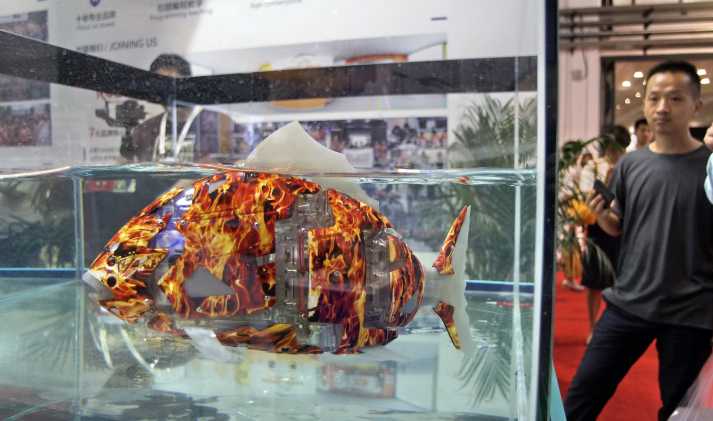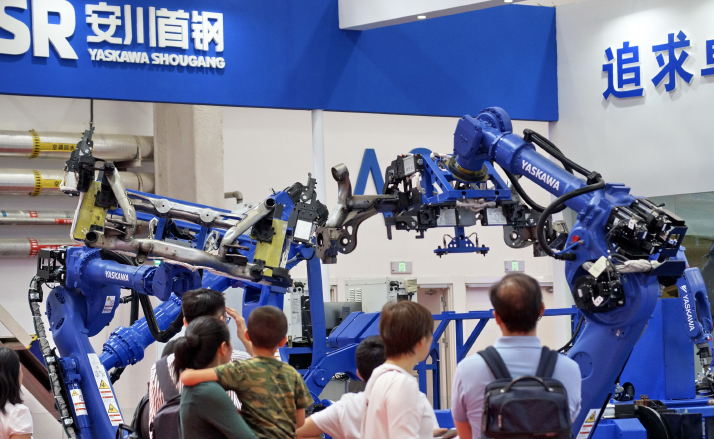|
||||||
|
||||||
| Home Nation World Business Opinion Lifestyle China Focus ChinAfrica Video Multimedia Columnists Documents Special Reports |
|
||||||
|
||||||
| Home Nation World Business Opinion Lifestyle China Focus ChinAfrica Video Multimedia Columnists Documents Special Reports |
| Nation |
| Robots Take Center Stage |
| A conference gives a glimpse into the opportunities and challenges facing the robot industry |
| Wang Hairong · 2019-09-02 · Source: | NO. 35 SEPTEMBER 5, 2019 |
 A fish-shaped robot at the World Robot Conference in Beijing catches visitors' attention on August 20
Wei Siwen, a graduate student studying neural engineering at Tianjin University, won the championship of a typing contest, not with her dexterous fingers, but with her brain and eyes. She earned the honor at a brain-controlled typing contest by achieving an information transmission rate of 691.55 bits per minute during the World Robot Conference 2019, held in Beijing on August 21-25. The speed is equivalent to outputting 145 English letters per minute, which is on par with the typing speed of a human using fingers. To perform brain-controlled typing, Wei wore an electro-encephalography (EEG) cap, which captures brainwaves through electrodes attached to the scalp. As she gazed at a letter on a virtual keyboard displayed on a small screen in front of her, her brainwaves were analyzed by a computer and the "typed" letter was displayed on a large screen connected to the EEG cap. The brain-computer interface technology, also called mind-machine interface, a promising technology that can be used to facilitate communication between people and devices, was one of the cutting-edge technologies on exhibit. The conference, attended by some 1,200 participants including representatives of 22 international robotics organizations, robotics experts, entrepreneurs and journalists, featured forums, an exhibition and contests. It was sponsored by the Beijing Municipal Government, China's Ministry of Industry and Information Technology and the China Association for Science and Technology (CAST). Robot technology has been positioned as an important strategic and priority sector worldwide, and various countries have formulated measures to boost its development, said Oussama Khatib, President of the International Foundation of Robotics Research and professor at Stanford University. "China is promoting high-quality development of the manufacturing industry, so accelerating the development of the robot industry is an important direction to take," said Miao Wei, Minister of Industry and Information Technology, at the conference. Robots in the limelight More than 180 well-known domestic and foreign enterprises showcased over 700 new and cutting-edge products. Various types of robots, including industrial, service, special-purpose and intelligent logistic ones, demonstrated their skills. Walker, a brand of humanoid robot developed by the Shenzhen-based company Ubtech, impressed visitors with its agility and dexterity. It opened a refrigerator door, grabbed a bottle of juice with one hand, came to a table and poured the juice into a glass in the other hand. The process was completed smoothly, just like a human would have done. Ubtech, founded in 2012, focuses on developing robots for housekeeping, entertainment and education. In February, at the star-studded Chinese New Year Gala hosted by China Central Television, six Walker robots dazzled the audience with a dance. The robots are also reported to be able to play games with kids, such as football. Bionic robots also amazed visitors at the conference. A bird-shaped robot exhibited by German company Festo flapped its wings, dashed toward the sky and then hovered for a while before landing accurately on its master's arm. Also eye-catching was a shark-shaped unmanned underwater robot called Roboshark displayed by Robosea, a company founded in 2015 and headquartered in Beijing. Roboshark was developed for underwater exploration. It has a shell made from sound-absorbing material and is powered by a three-joint caudal fin instead of a propeller, which not only enables it to move swiftly making very little noise, but also reduces energy consumption. Underwater robots have been employed to perform various tasks, such as dam and pipeline failure detection, underwater aquaculture, scientific research, and tracing and fishing. A variety of surgery robots were featured at the exhibition. Sinovation (Beijing) Medical Technology Co. Ltd. displayed a neurosurgery robot that uses a new-generation visual positioning technology to identify problems in the brain through non-contact laser scanning. Beijing Tinavi Medical Technologies Co. Ltd. displayed a robot for orthopedic surgery, which has been approved by the China Food and Drug Administration for clinical use. Musical robots with fingers nimbly playing keyboards, plucking guitar strings or banging drums added sound and fun to the exhibition.  Industrial robots exhibited at the World Robot Conference in Beijing on August 24
Large market At the conference, the Chinese Institute of Electronics (CIE) released the China Robot Industry Development Report (2019). According to the report, the global robot market has been expanding at an average rate of about 12.3 percent since 2014 and is expected to reach $29.41 billion in 2019, which includes $15.92 billion for industrial robots, $9.46 billion for service robots and $4.03 billion for special-purpose robots. During the same period, the size of China's robot market has been growing at an average rate of 20.9 percent, higher than the world average, the report stated. For six consecutive years, China has been the largest market for industrial robots. The CIE predicted that the Chinese robot market will reach $8.68 billion this year—$5.73 billion for industrial robots, $2.2 billion for service robots and $750 million for special-use robots. "In the first half of 2019, the global robot market was $14.4 billion while the Chinese robot market hit $4.25 billion," said Huai Jinpeng, Executive Vice President and Chief Executive Secretary of CAST. China is also a big robot producer. "In 2018, 148,000 industrial robots were produced in China, accounting for more than 38 percent of the global total," Miao said. Between 2016 and 2018, the annual output of industrial robots in China increased from more than 70,000 sets to more than 140,000 sets, at an average annual growth of more than 40 percent, said Xin Guobin, Vice Minister of Industry and Information Technology. China's locally produced service and special-purpose robots are advanced and have been used in increasingly diverse scenarios, according to the report. There is a huge demand for special-purpose robots for rescue and relief operations in natural disasters such as earthquakes, floods and extreme weather, as well as public safety incidents such as fires and mining accidents. China has made breakthroughs in some key technologies needed for developing special-purpose robots. However, the domestic industrial robot market is currently dominated by foreign companies. "Four giants in industrial robots, namely ABB of Switzerland, KUKA of Germany, as well as Japan's FANUC and Yaskawa, account for more than 70 percent of the Chinese industrial robot market," Luo Haoyuan, a partner at an investment company, recently told Science and Technology Daily. In 2018, domestic companies sold 43,500 industrial robots, up 16.2 percent year on year, accounting for 32.2 percent of the domestic industrial robot market, according to Economic Daily. Domestic Chinese companies aim to make breakthroughs in core technologies, having overcome some of the difficulties in producing key parts such as speed reducers, servo controls and servo motors, according to the report. Opportunities amid challenges Although China remains the largest market for industrial robots, its share of the world market dropped 3.7 percentage points in 2018, according to the CIE report. There were various reasons for the market slowdown, such as the deterioration of the international trade environment, mounting downward pressure on the global economy, and the downturn of major industries using industrial robots such as the automobile and electronics industries, said Xin. Wu Fengli, Chairman of Guangdong Topstar Technology Co. Ltd., a robot manufacturer in Guangdong Province, recently told the media that the robotics concept is very hot, yet the market is actually quite cold for many startups because it is difficult to make money. "The robot industry still faces many problems and challenges in its development process. But in general, robots are an important driving force for the shifting of economic drivers and high-quality economic development," said Miao. The CIE report showed that global service robots are ushering in a golden age of development. In China, the market for service robots is expanding rapidly. With the acceleration of an aging population comes a persistently strong demand for medical services and education, so service robots in China have huge market potential. The demand for service and special-purpose robots has increased significantly in recent years, at a rate higher than that of industrial robots, Xin said. Moreover, the development of 5G and Internet of Things technology has brought new opportunities to China's robot industry, he said. "The integration of 5G communication technology, the industrial Internet and robotics technology will greatly enhance the speed, integrity and throughput of data transmission, making robots significantly more intelligent, flexible and precise," Xin said. " This will enhance the potential use of robots and put the robot industry onto a fast lane of development." Copyedited by Rebeca Toledo Comments to wanghairong@bjreview.com |
About Us | Contact Us | Advertise with Us | Subscribe
|
||
| Copyright Beijing Review All rights reserved 京ICP备08005356号 京公网安备110102005860号 |